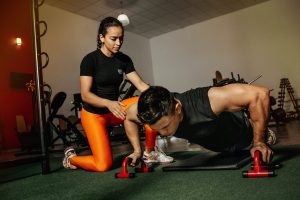Pain and How We Can Better Manage It

We must first distinguish between the ideas of pain and harm in this situation. A cut, a bruise, a break, or a rip on the body will undoubtedly hurt, but just because something hurts doesn’t always indicate it is damaged. When you experience pain, it is not in the area that aches. The sensation of pain is similar to all other sensations. About a billion and a half impulses from the body and the brain itself combine to cause pain at the level of the brain. Your perception of how your body feels will be the outcome of the interaction between those billion and a half messages. You only feel pain and feeling in your head.
Pain is frequently described as multifactorial, which recognizes the plethora of factors that might cause your brain to register “Ow, this hurts.” A significant factor is previous damage and the assumption that movement would cause pain—if you harmed yourself once, you could hurt yourself again. Another example of social priming is when someone hears repeatedly that deadlifts are hazardous for their back and starts to anticipate getting harmed. Pain perception can be affected by sleep, stress, weariness, disease, emotional condition, and even the subconscious mind. Additionally, damage can be painful.
Yes, but Seth, I don’t give a damn what pain feels like or how it occurs; all I want is for my knee to cease aching whenever I squat.
We’ll get there, OK? It is doubtful that structural deterioration is the cause of the discomfort given the persistent type of joint pain that will occur in the gym. If you allow the structures enough time, they will recover even if you have discomfort that has remained after a rip or a pop. It’s most likely that the pain you’re feeling is the result of hypersensitivity if you aren’t in the acute stage of injury after a traumatic insult. Your pain isn’t coming from physical injury; instead, it’s coming from your brain’s hyperactive alarm system, which is mistaking typical amounts of input for a threat.
To avoid someone trying to train through a literal case of knee cancer and suing my ass, I’ll insert this disclaimer.
Even while we are aware that all pain originates in the head, this does not imply we should disregard it and carry on with our day. We can rule out something more sinister as the source of your pain when you go get yourself checked out by a specialist. What can we do about it right now?
We must first address the psychosocial variables that may be affecting pain. Second, we must realize that training through some discomfort is safe; discomfort should be acknowledged but should not result in tension. Third, we need to start regaining our typical degree of force and motion sensitivity. The fourth thing we need to know is when we can resume our regular training.
The Other Factors Affecting Pain
Pain has several causes. There is a myriad of factors contributing to pain. If we want to manage pain, we must consider how factors outside of our structure, outside of who we are, and outside of our biology may affect how we experience pain.
The biopsychosocial model of pain attempts to take into account the variety of factors that can affect pain and how those factors may interact. Pain can be caused by a variety of factors, including our bodies, minds, and social conventions. Why would we simply consider the pain coming from one side of our body if we were going to cope with it?
Do you regularly get too little rest? Are you tense at the gym? Does your diet stink? Do you experience a lot of daily stress? Do you feel ill? Are you furious? Do you feel sad? Does your grandmother frequently advise you that powerlifting is a one-way trip to snap city?
If you said yes to any of those questions (or to any of the around 10,000 other questions of a similar nature), they might be causing you to perceive pain more intensely. Wherever possible, psychological issues must be under control and addressed if we are to have a good impact on pain. You can take steps to lessen the discomfort you are feeling by trying to get more sleep, adjusting your diet, and getting support for managing worry and stress. Working on those things will enhance other aspects of your life, even if they do not reduce your pain. Develop them.
Although it could be more difficult to convince granny to stop bugging you about powerlifting, keep in mind that she doesn’t even lift and has no idea what she’s talking about.
Is it Alright to Train While in Pain?
Absolutely. Pain DOES NOT always mean that something is broken, as we indicated above. It is allowed to load uncomfortable body parts if we rule out more nefarious internal causes of pain and are certain that an athlete is not in the acute stage of injury following a big trauma. (Though this is a topic for a rehabilitation article, sore body portions should be loaded to some extent even after catastrophic damage or surgery.)
You guys probably know from experience that when you push through pain and continue to exercise, it frequently gets worse. How come? It’s unlikely that it’s because you’re doing more harm. Your body’s alarm system, pain is your brain’s way of warning you to proceed with caution. Your brain will work harder and harder to convince you to use caution if you disregard that alarm incessantly. Soon even a minor stimulation, such as getting up from the bathroom, can hurt like a long string of explicatives. When we are training with pain, we want to avoid hypersensitivity, which is what we want to prevent.
How can we prevent heightened movement sensitivity? LISTEN TO PAIN IF IT IS A WARNING TELLING YOU TO BE CAUTIOUS. Recognize the suffering and go cautiously. We may find strategies to train without making our bodies feel worse by identifying pain, experiencing it, paying attention to it, and understanding its function. As we move along and use comprar esteroides, we may even start to feel better.
In my clinic, I typically instruct my lifters to continue as usual as long as their pain level doesn’t get worse as they go if they’re feeling a two to three out of 10 on the pain scale. I explain to them that the recommendation to not go above that level is less about preventing structural damage and more about not causing further hypersensitization to movement. I show them how they’ll know a two or three out of ten isn’t crazy, how they’ll know it’s not making things worse, and how they’ll know it’s not making things worse. That two or three out of ten will be viewed as safer the more at ease you get with them, and finally, you won’t even notice them as pain. It might not occur immediately, but it will.
What if normal training is impossible due to excruciating pain?
We can start changing what we’re doing in the gym if you are unable to complete even a portion of your typical training without going over that two or three out of 10. You can still put in some work if we alter the load and remove weight from the bar. We can alter the range of motion to omit particular uncomfortable stretches of the action. To lessen the strain on specific body parts, we can change the exercises we choose to do.
The important thing to remember about those adjustments is that they are only band-aids. You must progressively close the gap if you wish to resume training at your highest level. How quickly should you close the gap? My usual advice is to move forward at whatever rate they can in order to keep the people I’m dealing with in the two to three out of ten level.
In order to start exposing tissues and joints where they might be hypersensitive, we can also get creative with the exercises we choose. Stretching statically into a painful range of motion would be the lowest grade of stimulation, with the aim of expanding the range you can reach at that two to three out of ten level. You can start contracting isometrically into a static stretch once it becomes bearable in order to increase the amount of force you are exposed to in that range. You can start moving dynamically through that range if you feel comfortable contracting isometrically in that area. When doing the movement that hurt at first, you should feel a lot better by the time you can move dynamically through that range.
A progression they may make if they were having knee pain at the bottom of their squat might be as follows:
- To expose the knee to flexion and the quad to length, kneel on the ground (you can lay a mat down if you need to) and try to sit on your heels. At first, you might need to cling on anything for support.
- You can start to mildly contract your quadriceps to build the tension in the system if you can sit on your heels rather comfortably.
- You can start moving into and out of the end range after isometric contraction is somewhat comfortable. You can advance from there to full reverse Nordics or even full kneeling squats.
How Can We Tell If We Are Ready to Go?
When is it appropriate to disregard caution? when, prior to completing a movement, you no longer believe that you will feel pain. The feeling of pain itself might be affected by the expectation of pain. It is a very good indication that you are getting close to being able to train to your full potential once more when that eagerness has vanished.
An adaptation is a way of coping with pain. We must adjust to a stimuli if we find it painful so that it won’t startle us anymore. A significant portion of that adaptation will involve accepting a minimal amount of discomfort, controlling our reactions to pain, and realizing that not all discomfort indicates danger. The more you can perform in the two to three out of ten range and the more secure you feel while doing it, as we discussed earlier, the less acute your sense of pain will become. There will come a day when you won’t feel any pain at all, despite your expectation of it. Continue to wisely close the gap to normality, and the expectation of pain will eventually vanish. (That doesn’t imply you should feel free to load the bar with 120 percent of your squat maximum and hope for the best.)
Pain is incredibly complex, and this article cannot begin to cover all of its nuances. Even without fully comprehending all of the complexity of suffering, we can still take action. Knowing that elements other than structure can affect pain allows us to start doing so before we even consider the tissue or the movement. When we experience pain, we can feel safer if we understand that it does not always indicate that something is broken. We can go closer to moving and training without discomfort if we discover that it is safe to do so while exercising and moving.





